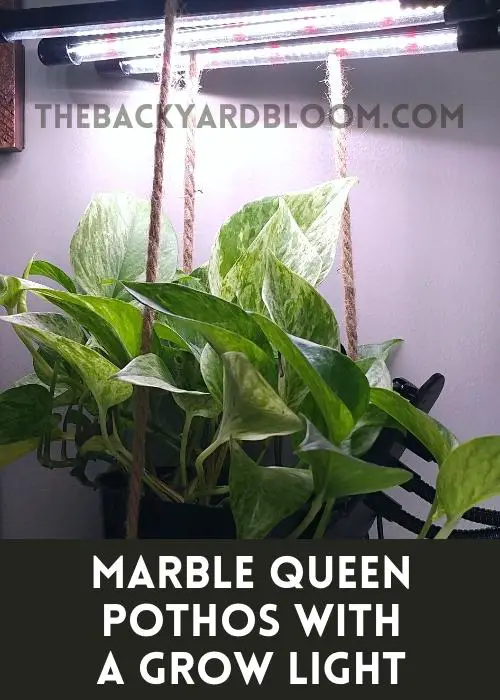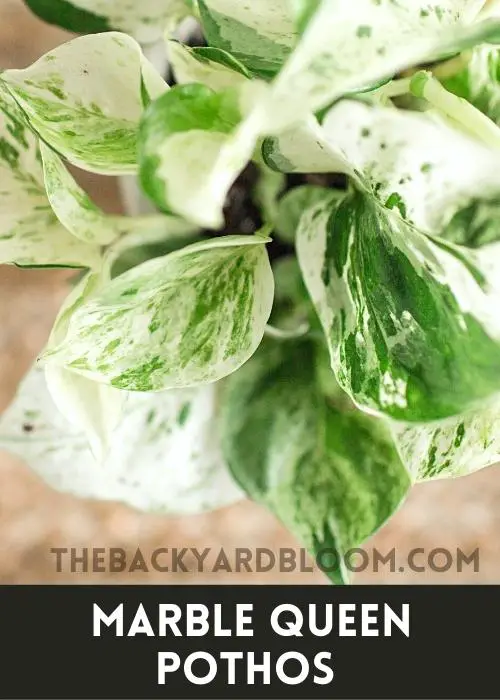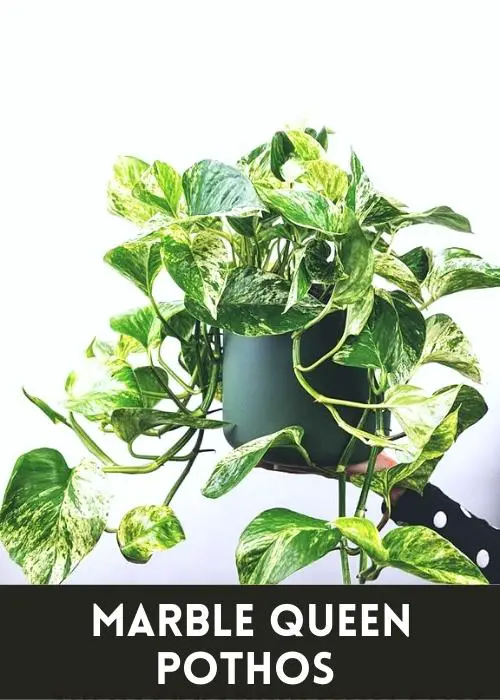Marble Queen Pothos plants are a common type of pothos that you will see in many plant nurseries and big box stores that sell house plants. With the beautiful variegation that Marble Queens have they are quite popular since they are so eye-catching. Most pothos plants have the same required care, but there are some subtle variations, especially when it comes to the light that the plant needs. If you have a new Marble Queen read on to see how to care for a Marble Queen Pothos.
- Origins of The Marble Queen Pothos
- Marble Queen Pothos Watering
- Marble Queen Pothos Light Requirements
- Marble Queen Pothos Soil
- How To Repot a Marble Queen Pothos
- Marble Queen Pothos Fertilizer
- Temperature
- Humidity
- Marble Queen Pothos Propagation
- Marble Queen Pothos Plant Toxicity and Pets
- Common Problems With Marble Queen Pothos Plants
Origins of The Marble Queen Pothos
Marble Queen Pothos plants are a form of variegated pothos that has been hand-selected and bred due to their popularity with houseplant enthusiasts. This hand selection is reported to have begun in the 19th century. Regular pothos plants are originally from French Polynesia, but these were not the variegated type. Marble Queens have become quite popular to have nowadays in households due to their beautiful variegation with creamy white and green leaves.
Like the other varieties of pothos plants, Marble Queens can be invasive in tropical climates. It has become an issue in Sri Lanka with various varieties of pothos and has also been listed as invasive in the State of Florida by the USDA.
It is a vining plant that in its natural habitat grows by running along the ground and then up tree trunks. In its natural conditions, its vines can grow up to 40 feet long. In an indoor environment, they usually grow only up to 8 feet long. Some people do achieve longer vines by having really good growing conditions.
Other Pothos Care Guides:
- Cebu Blue Pothos Care
- Neon Pothos Care Guide
- N’Joy Pothos Care Guide
- Global Green Pothos Care
- Baltic Blue Pothos Care Guide
- Pothos Plant Care
- Jade Pothos Care Guide
- Pearls and Jade Pothos Care Guide
- Manjula Pothos Care Guide
- Golden Pothos Care Guide

Marble Queen Pothos Care Guide
Marble Queen Pothos Watering
Allow the soil to dry out between watering your plant. If this is not done, and the plant is left sitting in constantly soggy soil and old water, root rot can occur. Root rot is very hard to get a plant to recover from and most plant owners lose their plant if it gets root rot.
Watering will also depend on light levels. Marble Queens that are in bright light tend to need water more frequently than one in lower light conditions.
Check the soil moisture level by sticking your finger into the soil a couple of inches. If it is dry it is time to water your Marble Queen. If it is still moist hold off on watering your plant and check again in a couple of days. Another way to check the soil moisture levels is to use a moisture meter.
Another visual clue that the soil is dry and the plant needs water is that the leaves have become droopy. If you notice droopy leaves and the soil is dry, water the plant. Don’t wait longer to water in this situation or you could start to lose some of the vegetation.
Marble Queen Pothos Light Requirements
Just like any pothos plant, the Marble Queen does not like direct sunlight. Getting direct sun on the leaves for too long can lead to the pothos plant getting burned.
Marble Queen Pothos plants do best with indirect bright light. You can also substitute some of the light with a grow light like the picture below. One of my Marble Queen Pothos is not in a window and the extra light from the grow light helps the variegation continue to be present in the new growth on the plant.

Related Reading: Why Is My Marble Queen Pothos Losing Variegation?
Marble Queen Pothos Soil
Pothos are not too picky about the soil that they are planted in.
A regular potting mix will work just fine. If you worry about drainage, then add some perlite to the mix. (What is perlite used for?)
Leaving the plant sitting in soggy soil can lead to root rot. Always make sure you have soil that allows for drainage. Anything too compact will lead to the roots being in stagnant water.
How To Repot a Marble Queen Pothos
Most of the time pothos plants need to be repotted every two years or so. This can sometimes be every year if your Marble Queen is growing fast and becoming root-bound often.
If you start to see the leaves getting droopy even though you water it enough, then it might be time to repot the plant. This is a sign of it being root-bound. This can cause issues with the plant being able to take up enough water and nutrients to grow and thrive.
Pick out a new pot that is about 2 inches bigger than the old one. Also, pick one that will allow for good drainage. Just like soil that doesn’t allow for drainage, a pot that doesn’t have drainage can lead to root rot too.
After you have put your pothos in its new pot and soil, water it well.

Marble Queen Pothos Fertilizer
Fertilizing for Marble Queens does not need to be done often, they are not a heavy feeder. You only need to fertilize it about once or twice a year.
Liquid fertilizer is best to use. Only use half of what is recommended on the fertilizer’s directions.
Temperature
Marble Queens prefer to be kept in temperatures above 50 degrees Fahrenheit.
They do not tolerate cold well. And being in a cold draft will also cause issues with the plant.
Humidity
While Marble Queen Pothos plants aren’t too picky about humidity, they are tropical plants. Keeping humidity above 40% is best. If it goes lower you will probably notice that it needs to be watered more often.
One way to help keep the humidity up is to use a humidifier near your plants.
Marble Queen Pothos Propagation
The most popular way to propagate a Marble Queen pothos plant is to use stem cuttings and put them in water.
Just cut off a leaf with its stem attached and place it in some water and it will grow roots.
After they have grown roots put them in a pot with soil so they can start getting some nutrients to continue their growth.
You can find step by step instructions here: Propagating Pothos Cuttings in Water
Marble Queen Pothos Plant Toxicity and Pets
According to the ASPCA, all Pothos plants are toxic to both dogs and cats.
If you do have pets it is best to let your pothos grow up high out of reach of your animals. And use a homemade citrus spray or a spray like Bitter Apple to deter them from chewing on your plant.

Common Problems With Marble Queen Pothos Plants
Brown Spots
Brown spots can be caused by burning from sunlight, see our article Can a Pothos Get Sunburn? if you have burned leaves on your plant.
Another reason brown spots could appear on the leaves of a Marble Queen pothos plant is due to root rot. Oftentimes these brown spots will be mushy to the touch. Make sure that the soil is drying out between watering and that the pot is draining well.
Related Reading:
Why Does A Marble Queen Pothos Get Brown Spots?
Brown Edges
Brown edges on the leaves can indicate that the plant is going too long between waterings. This is due to damage from lack of water. It is best to remove these leaves that have damage and increase watering frequency.
Yellow Leaves
Yellowing leaves can be a sign of overwatering. Check the soil moisture levels and see if there could be an issue with the pot draining well.
I have also had yellowing leaves due to a lack of nitrogen in the soil. Make sure you are fertilizing your plant a couple of times each year. You can also water the plant with worm tea to help add nitrogen.
Related Reading:
Why Does a Marble Queen Pothos Get Yellow Leaves?
Why Is My Marble Queen Pothos Not White?
Root Rot
Root rot is the number one way people lose Marble Queen Pothos plants.
If the plant is left sitting in soggy soil root rot can become an issue. This can be due to too much water, poorly draining soil, or a pot that is not allowing drainage.
Always make sure to let the soil dry out between watering, have well-draining soil, and have your plant in a container that allows for drainage.
Pests
Marble Queens are a hardy plant when it comes to the common house plant pests.
Mealybugs however can be an issue on pothos. These are small fluffy-looking white bugs. They can decimate plants if they are able to multiply. The best way to combat mealybugs is to use insecticidal soap or neem oil.
Another way that you can try to control these is to use a Qtip soaked in rubbing alcohol to take them off the plant. But I have never been able to stay ahead of an infestation by just using this method. And it is a very tedious way to try and control them.


